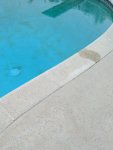I still feel like something is not right with your system. I get that products are often ‘optimistic’ when they list specifications, but in your case getting 1/3 of the published output seems to be well beyond that.
I’ll test this with my RJ-30+ tonight and see what I come up with. I’m going to wait until this evening though because I know that if I did it during the day the direct sunlight would affect the results.
According to poolmath, running my RJ-30+ at 100% for four hours should produce 2.1ppm of chlorine in my 14364 gallon pool.
I’ll let you know how it goes.
On a side note, did you double check the cell type listed in your RJ-60+ to make sure that it is listed correctly? And even check the sticker on the cell itself to make sure that you really do have an RJ-60+ cell.
I’ll test this with my RJ-30+ tonight and see what I come up with. I’m going to wait until this evening though because I know that if I did it during the day the direct sunlight would affect the results.
According to poolmath, running my RJ-30+ at 100% for four hours should produce 2.1ppm of chlorine in my 14364 gallon pool.
I’ll let you know how it goes.
On a side note, did you double check the cell type listed in your RJ-60+ to make sure that it is listed correctly? And even check the sticker on the cell itself to make sure that you really do have an RJ-60+ cell.










